Speech The Way We Pay: Now and in the Future

Tony Richards
Head of Payments Policy Department
The Australian Savings & Deposits Conference 2014, Sydney
Sydney –
- Audio 12.3MB
- Q&A Transcript
I will be speaking today on two topics. First, I will provide a summary of some new payments research from the Reserve Bank. Second, I will give a brief update of progress on the New Payments Platform, a major industry initiative to put in place some new payments infrastructure that will spur innovation in the Australian payments industry.
Let me start with the new research into the payments behaviour of Australian households. In 2007 and 2010 the Bank conducted detailed diary surveys of consumers' use of payments. Today the Bank is releasing the results from its third such study, which was conducted in late 2013. The Research Discussion Paper written by my colleagues Crystal Ossolinski, Tai Lam and David Emery will be available later this morning on the Bank's website. I am going to summarise some of their findings for you.
The Bank contracted a research firm to conduct a survey with three elements: a pre-diary questionnaire about the demographic characteristics of respondents; a seven-day payments diary; and a questionnaire about respondents' payments preferences and attitudes.
The response rate was good, with a final sample of over 1,150 respondents, selected to be representative of the Australian population in a wide range of aspects. For the first time, the survey was completed by most respondents online rather than on paper.
The diary provides details of all payments and transfers made by respondents over a seven-day period. This includes details of the amount, the payment method and channel used, and the type of merchant. It is a very rich database, with detailed information on over 15,500 payments that will allow us to study a range of research questions. And when we attempt to aggregate the survey results, the overall picture looks very like the macro-level retail payments statistics data that the Bank publishes, which lends credence to the survey results.
Not surprisingly, the survey shows that cash is used most often for small transactions (Graph 1). For example, it is used in nearly 80 per cent of transactions of $10 or less. This is not surprising as cash has many advantages in terms of convenience for both consumers and merchants. Then as transaction size increases, the use of debit cards initially increases most, then credit cards, then electronic payments such as BPAY or internet banking, and then cheques. I imagine that most people looking at the results of the study will relate to this ordering.
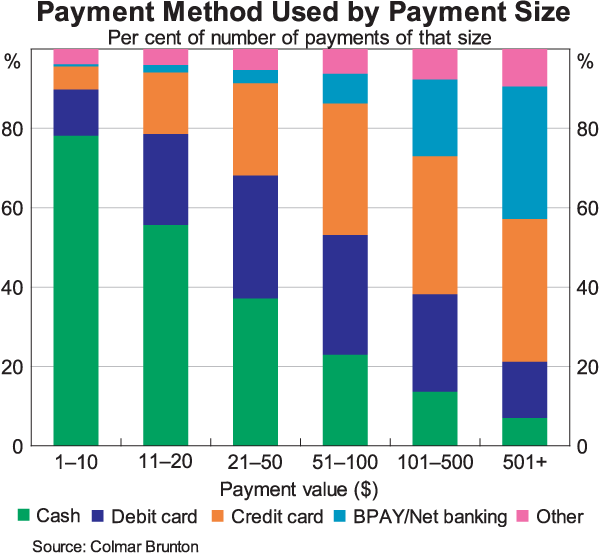
The 2013 results indicate that many of the trends that we observed in the 2010 study have continued. Looking at the share of the number of all transactions, there has been a continuing decline in the use of what we have traditionally called the ‘paper-based’ methods. While cash remained the most frequently used payment instrument, being used in 47 per cent of all transactions, its relative importance has fallen significantly since 2010 (Table 1). Cheque use also continued to fall. These trends have been mirrored by an increase in various forms of electronic payments, with a significant increase in the use of debit, credit and charge cards, and also an increase – from a small base – in the use of PayPal.
| 2007 | 2010 | 2013 | ||||
|---|---|---|---|---|---|---|
| Cash | 69 | 62 | 47 | |||
| Debit, credit and charge cards | 26 | 31 | 43 | |||
| BPay | 2 | 3 | 3 | |||
| Internet or phone banking | n/a | 2 | 2 | |||
| PayPal | n/a | 1 | 3 | |||
| Cheque | 1 | 1 | 0(a) | |||
| Other | 1 | 1 | 2 | |||
|
Note: (a) rounds to zero Sources: Colmar Brunton; Roy Morgan Research |
||||||
Looking across age groups, cash is used more by older individuals than by younger ones (Graph 2). But the decline in its share of all transactions is evident across respondents in all age-groups. The decline is also fairly broad-based across different types of merchants. It can be partly explained by the fact that the mix of transactions in the economy is gradually shifting from in-person to online, where cash is essentially not used. However, it is mostly a function of the decline in cash use in the traditional point-of-sale environment and the development of newer electronic technologies that can match or surpass the convenience and speed of cash in some types of transactions and transfers.
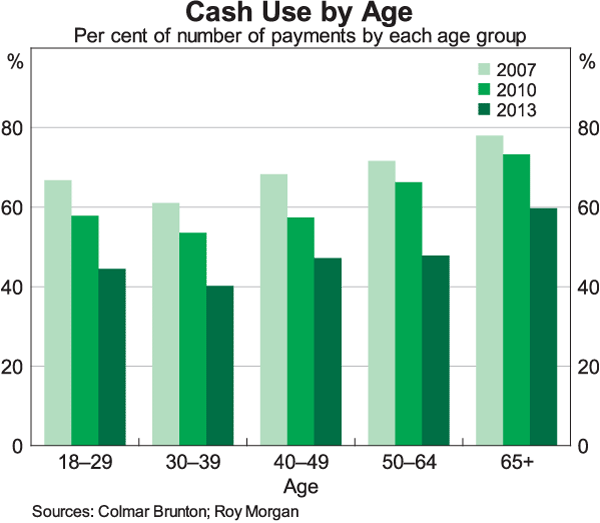
While the survey confirms that the rate at which cash changes hands is falling, there are few signs that holdings of cash are doing so. We know from the aggregate data that banknotes on issue have for a long period grown broadly in line with the nominal growth in the overall economy. And the consumer use survey suggests the amount of cash in respondents' wallets grew between 2010 and 2013. Together this evidence suggests that it continues to have a significant role both as a store of value and for precautionary use when other means of payments are not available.
The flip-side to the declining use of cash has obviously been the rise in the use of payment cards for transactions of all sizes (Graph 3). This has been associated with continuing growth in the number of card terminals in Australia (up by around 35 per cent over the six years to 2013), and advances in card technologies and authentication methods. The ongoing shift to the use of PINs in card transactions and the sharp pick-up in the use of contactless payments have both resulted in a reduction in the typical time needed to complete a card transaction.
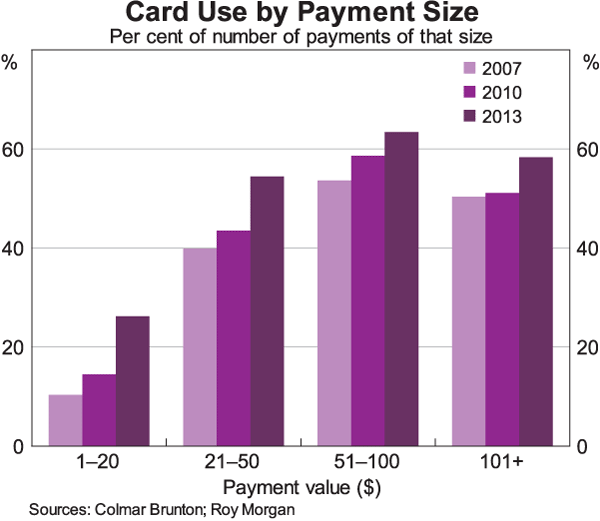
In the latest survey, two-thirds of respondents reported that they had a card with contactless functionality and almost half of these reported a contactless transaction in the week of the study. Contactless transactions accounted for 22 per cent of all face-to-face card transactions. This share was significantly higher for payments under $20 (Graph 4).
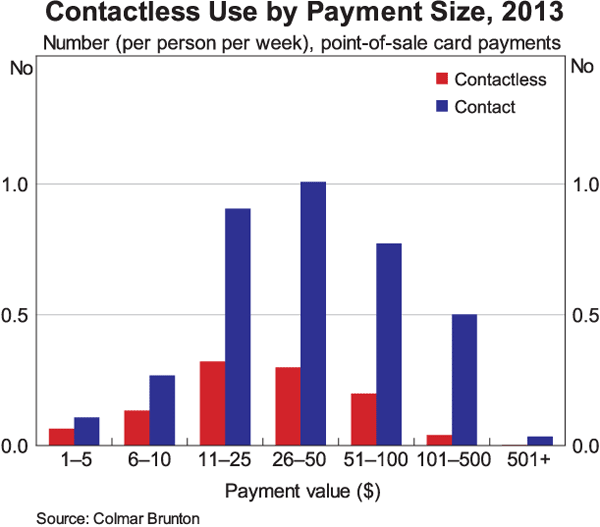
The use of contactless was higher for respondents that reported that speed of transaction was an important factor in choosing which payment to use. The survey also shows that contactless was used more frequently at retailers such as supermarkets, petrol stations and take-away food stores where the speed of the payment is likely to be important for the cardholder and/or the retailer.
The survey provides evidence that contactless card payments have been displacing both cash and signature or PIN-authorised card transactions. However, on balance, based on a post-survey question, it seems that the greater effect has been for contactless to displace traditional card transactions.
The survey shows that there are significant differences in the use of debit and credit cards across demographic groups. Younger households are much more likely to use debit cards than credit cards, presumably reflecting reduced access to credit cards and a preference to ‘use their own money’ (Graph 5). Lower income households also use debit more frequently than credit, most likely for similar reasons. However, those in the highest income quartile use their credit card significantly more than their debit card. This may well reflect the greater desire to get reward points associated with credit card use. The survey shows that an individual in the highest income quartile is six times more likely to have a premium credit card than a household in the lowest income quartile.
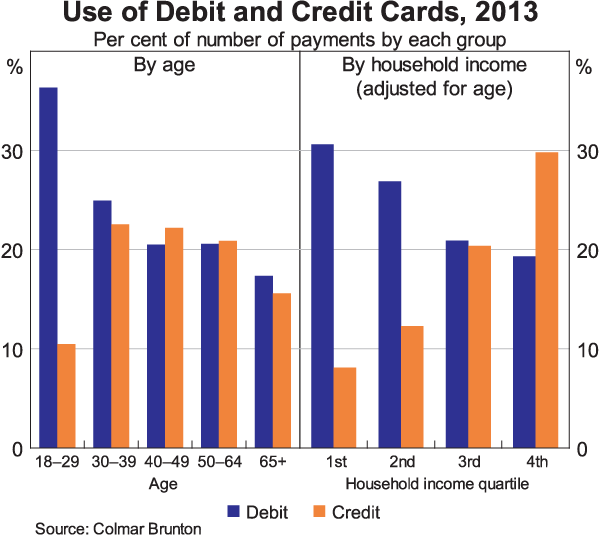
Not surprisingly, the survey shows a significant decline in the use of cheques. Around 80 percent of respondents reported that they had not written a cheque over the previous year. Cheque use is especially low in younger age groups (Graph 6). However, it is also declining significantly in older age groups. We can expect the decline in the use of cheques to continue as other payment methods became available to meet either the needs of households that currently still prefer to use cheques or the needs of businesses that find there are few alternatives for some specific uses. This is something that the industry is working on, and the delivery of the New Payments Platform (which I shall speak about shortly) will provide an opportunity to continue this process.

The survey also provides evidence on the growth of some relatively new means of making payments or transfers.
- For example, it shows that PayPal was used for around 3 percent of transactions in 2013, up from around 1 per cent in 2010. This mostly reflects an increase in the share of transactions occurring online and an increase in PayPal's share of that market.
- Smartphone payments are an area of strong innovation in the payments system. The survey shows that there is a shift toward making more person-to-person transfers using smartphones, with around 9 per cent of transfers to family and friends made via smartphone. However, the use of smartphones for payments was still low, at less than 1 per cent of consumer payments to businesses. It appears that, for the time being, smartphones are mostly a convenient alternative method of internet access, rather than a means of payment in their own right. This clearly has the potential to change as new near-field communications (NFC) or Bluetooth technologies for point-of-sale smartphone payments emerge.
Finally, the survey provides some evidence on the effects of some policy reforms implemented by the Bank over the past decade.
One such reform was to the ATM system in 2009. The intent was to provide greater transparency in ATM fees and to allow ATM owners to better recover their costs. This related to fees paid on transactions at ATMs not owned by the individual's financial institution, so called ‘foreign’ transactions. For cardholders, the main change was not in terms of the level of fees paid on a transaction, but in the transparency of those fees. In particular, if there is a fee, the individual must now be notified prior to authorising the transaction rather than in their subsequent monthly statement. The reforms have had a significant impact, with the 2013 survey showing that only 15 per cent of ATM withdrawals incurred a fee, down from 23 per cent in 2010. A small change in the transparency of a fee has had a significant effect on consumer behaviour.
The survey also provides some evidence on the Bank's reforms that required card schemes to remove their no-surcharging rules in 2003. This was followed in 2013 by a change to allow card schemes to limit surcharges at the reasonable cost of card acceptance. This change was intended to find a reasonable balance between the schemes' desire to prevent ‘excessive’ surcharging and the merchants' right to recover reasonable costs.
We know from other surveys that a significant fraction of merchants impose a surcharge on card transactions from one or more card scheme. Where merchants do levy a surcharge, they are more likely to surcharge more expensive payment methods and the typical surcharge is higher for more expensive payment methods. However, the current survey showed that only 4 per cent of card transactions attracted a surcharge, indicating that consumers have proven to be pretty good at switching away from surcharged means of payment. In addition, the survey provides evidence that consumers who are willing to pay surcharges are more likely to place a value on rewards programs than those who do not pay surcharges.
The Bank has signalled in its submission to the Financial System Inquiry that the Payments System Board will be continuing to study the issue of surcharging and especially the incidence of apparent excessive surcharging. However, it is important to remember that some payment methods – for example credit and charge cards that provide the cardholder with significant rewards – can be very expensive for merchants. Accordingly, it is important – subject to appropriate disclosure and also that there is at least one payment method that is not surcharged – that merchants should be allowed to surcharge for more expensive methods. This is, of course, not just an issue for some high-cost cards: we may find, for example, that it becomes more relevant for cash and especially for cheques as their use falls and costs increase.
Related to this, I should note that the consumer use survey is not the only work that the Bank has been doing to improve our collective understanding of the payments landscape.
In particular, the Bank is currently undertaking a large-scale review of the costs borne by financial institutions and merchants in accepting different payment instruments. A comprehensive exercise like this one was last undertaken in 2007. This year's exercise involves a wide range of entities – including a number represented today – and is examining the costs of a number of payment methods at a relatively fine level of detail. It will also involve a survey of small- and medium-sized merchants so that we understand how the costs borne by smaller merchants differ from those borne by larger ones. We have benefited from a number of rounds of consultation with financial institutions, merchants and associations, and will be continuing to work closely with these entities until we publish the report towards the end of the year.
Moving on, I would like to give you an update on progress with the industry's New Payments Platform (NPP) project.
It is almost exactly two years since the Bank released the conclusions of its Strategic Review of Innovation in the Payments System.
In the Review, the Payments System Board (PSB) identified a number of gaps in the services currently provided by the payments system.
Among these were:
- the ability for individuals to make electronic payments with real-time funds availability to the recipient
- the ability to make and receive such payments outside of normal banking hours
- the ability to address payments in a relatively simple way, such as to an individual's mobile phone number or email address rather than to their BSB and account number
- and, most relevant for businesses, the ability to send anything more than a minimal amount of information with an electronic payment.
Accordingly, the PSB set a number of strategic objectives to deal with these gaps. In response, the payments industry has come together to work on a project that aims to meet these objectives. It is working on a project known as the NPP, which will establish a completely new set of infrastructure.
As recommended by the PSB, the industry's NPP solution will be based on a hub-based infrastructure. That is, financial institutions will connect to a central set of shared infrastructure. This will be more efficient and access-friendly than the bilateral links that characterise much of our existing payments infrastructure. For example, a new entrant will only have to make a single connection, rather than establishing bilateral links with all the existing players. It will also be more innovation-friendly, in that there will be a central body, an industry-run Utility Company that will be able to coordinate upgrades to the infrastructure.
Together, the payments hub or ‘switch’, the communications network and the central addressing service that is being built will be known as the ‘Basic Infrastructure’. This infrastructure will link financial institutions such as banks, credit unions and building societies, as well as other approved entities.
It will allow the exchange of fast, flexible, data-rich payments messaging. It will be available to support new types of payments services that can be tailored to particular needs of customers, including ones that we may not yet have thought of. It will be linked to a Settlements Service built by the Reserve Bank which will provide real-time interbank settlement of each NPP payment.
All of this new infrastructure will be available on a close to 24/7 basis.
While many types of services will be enabled by the NPP, the first will be developed cooperatively by the industry. It is currently being called the ‘Initial Convenience Service’ and is expected to focus on real-time person-to-person payments using mobile channels. While some banks currently provide services like this, they effectively only provide real-time payments if the two parties are customers of the same bank.
The project is being overseen by a Steering Committee that includes representatives from a wide range of institutions, both large and small, as well as the Reserve Bank and the Australian Payments Clearing Association (APCA). The Committee is working to implement the NPP by the end of 2016, consistent with the targets set in the Strategic Review.
The current focus of the Committee is on the selection of vendors to provide the Basic Infrastructure and Initial Convenience Service. It is expected that the successful vendor or vendors for the Basic Infrastructure will be announced in August. There is currently also a lot of work underway to establish the Utility Company that will own and govern the Basic Infrastructure.
The PSB has been keenly watching the progress of the NPP.
The Board expects that the NPP will create a good platform for future innovation. It has been particularly encouraged by the way that the industry has come together to work on the NPP. It is conscious of the substantial commitment of time and resources that the industry is making in this project in response to the strategic objectives identified by the Bank. This investment will deliver significant benefits for the Australian economy. It should also help ensure that the institutions that are currently providing payments services to Australians remain relevant in the future too.
The centralised infrastructure and real-time nature of the system, combined with the flexibility of payment messaging, ability to carry additional remittance information and the easy addressing capability, will mean that payments can be better integrated with many other aspects of our lives. Businesses should be able to achieve substantial efficiency gains and there will be significant improvements to the timeliness, accessibility and usability of the payments system for consumers.
If implemented effectively, the NPP will place the Australian payments infrastructure at the global frontier.
All in all, it is an exciting time to be in the Australian payments industry.